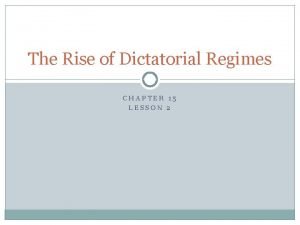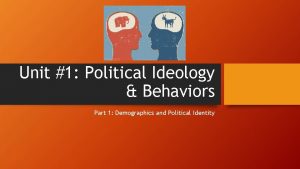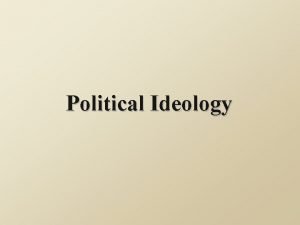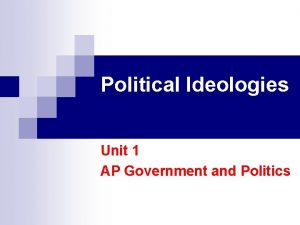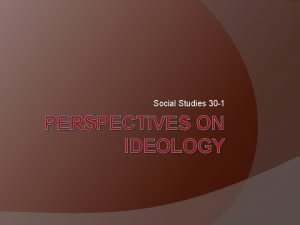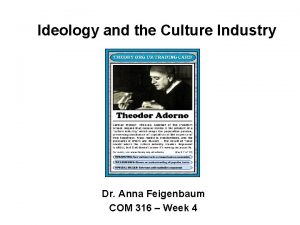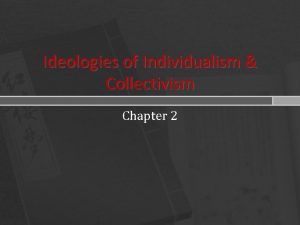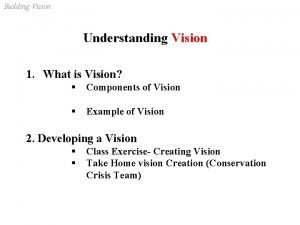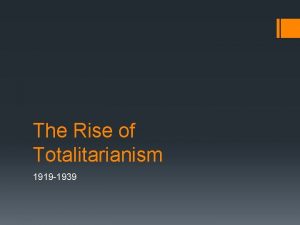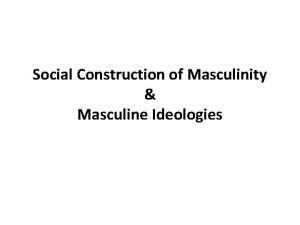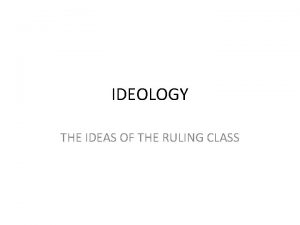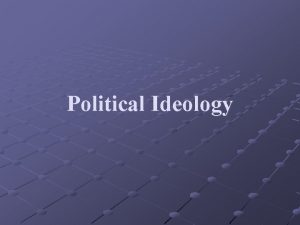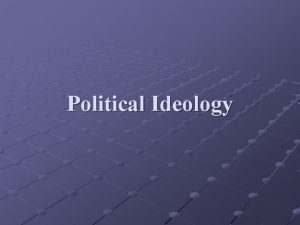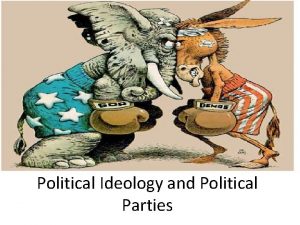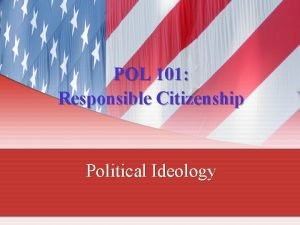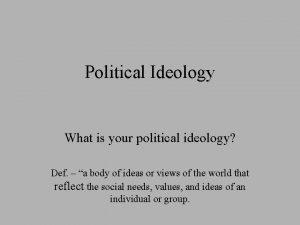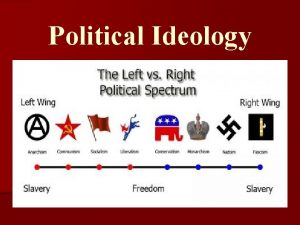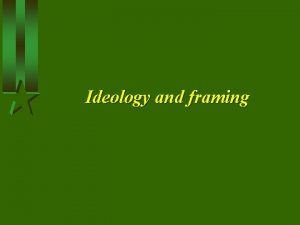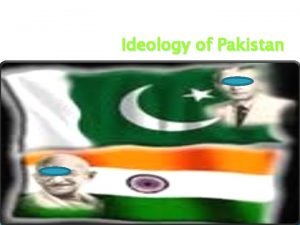THE RISE OF FASCISM FASCISM A POLITICAL IDEOLOGY



















- Slides: 19

THE RISE OF FASCISM

FASCISM – A POLITICAL IDEOLOGY -- 1919 - 1945 Intensely nationalistic ideology Praised violence against enemies Celebrated action – rather than reflection Fascists placed their faith in a charismatic leader. Fascists bitterly condemned. . . • Individualism, liberalism, feminism • Parliamentary, democracy, communism Fascists were revolutionary Fascists celebrated tradition and rejected modernity

TO WHOM DID FASCISM APPEAL? People with grievances – from all classes • Threatened by socialism and communism • Threatened by the rising power of corporations • Demobilized soldiers • Intellectuals appalled by modern values Many had lost faith in capitalism Many had lost faith in democracy

FASCISM IN EUROPE Fascist movements appeared in all over Europe Some had very little political impact • France, Great Britain, the Netherlands Some had a greater political impact. • Austria, Hungary, Romania Spain • Rise of a fascist movement led to civil war • 1936 – 1939 • Francisco Franco

FASCISM IN LATIN AMERICA Conservative and authoritarian regimes Adopt the trappings of fascism • one-man rule • state-controlled parties • anti-Semitism • youth organizations or militias • a rhetoric of national renewal

ITALY Italy became a unified state 1870 Conservative landlords dominate rural areas Industrialization created social tensions Demobilized soldiers • out of work and angry Italian patriots • thought Italy should be bigger

ITALY IN THE 1920’S Economic problems led to social unrest Left-wing groups causing trouble in Italy Protests threatened the social order Benito Mussolini (1883– 1945) Charismatic orator and a former journalist The symbol of this movement was the fasces • A bundle of birch rods bound together around an axe • A symbol derived from ancient Rome

BENITO MUSSOLINI October of 1922, Mussolini was swept into power His private army – the Blackshirts As Prime Minister he consolidates power • Establishes a totalitarian state • He becomes the supreme leader – Il Duce

MUSSOLINI’S FASCISM Anticommunist and antidemocratic To Fascists, the state was a conscious entity • With “a will and a personality. ” • Individuals exists only in relation to the State For communists it was “the people” • for fascists it was “the state” Consolidates power of the central state Invoked aspects of traditional Italian life • The Catholic culture of Italy The new Roman Empire -- Invades Ethiopia (1935)

GERMAN FASCISM The Nazi Party Lead by Adolf Hitler – Chancellor, 1933 Like Italian fascism, German fascism • extreme nationalism • violence as a political tool • single-party dictatorship • led by charismatic figures • hated democracy and communism • glorified war

THE ORIGINS OF GERMAN FASCISM World War I led to collapse of Germany Treaty of Versailles added to Germany’s humiliation Many Germans blamed civilians leaders for loss and humiliation German economy was in bad shape Many Germans reject moderate political parties

ADOLF HITLER Hitler consolidated Nazi control of Germany • Outlaws other political parties • Outlaws labor unions • Arrests political opponents • Takes control of the media By the late 1930 s, most Germans support Hitler • Brought Germany out of the Depression • Restored Germany’s military

“THE MASTER RACE” Many Germans believe they are a superior race • The Aryan Race – The Master Race German women encouraged to have children Fascists opposed family planning Celebrate German “folk” & German nationalism Hitler, a mesmerizing orator, became the Führer

ANTI SEMITISM Nazi’s celebrate the past, reject modernization Jews became the symbol of modernization Anti-Semitism had deep roots in much of Europe Hitler’s book Mein Kampf (1925) • Calls for the racial purification of Germany • Nazis want to rid Germany of its Jewish population • World War II he implements his “final solution” • Mass extermination of the Jewish race • Six million European Jews

THE MORAL COLLAPSE WITHIN THE WEST Reject the good ideas from Enlightenment culture • Rationalism, tolerance, democracy, equality Celebrate the West’s really bad ideas • “scientific racism” Nazis believed in human perfectibility • Social engineering necessary to achieve it • Exterminating or sterilizing the imperfect

JAPAN -- POST WORLD WAR I Modern Japan similar to Italy and Germany • Newcomers to “great power” status • Limited experience with democracy • Authoritarian governments in the 1930 s But Japan was distinct as well • Minimal participation in World War I • Economy grew during World War I • Japan was an equal participant at Versailles • Embracing western political and cultural values

THE GREAT DEPRESSION Japan hit hard by the worldwide economic collapse • High unemployment • Widespread poverty The right-wing in Japan cannot exploit the crisis • No fascist party in Japan • No charismatic leader in Japan Established institutions strong enough to prevent fascism

MILITARY TAKES GREATER POLITICAL CONTROL 1930 s Military -- more dominant in Japanese political life • Parties and the parliament continued to operate • Key positions go to bureaucratic or military figures • Censorship limits free expression Rise of military is understandable given Japan’s history • The samurai warrior class Japan recovers quickly from depression State assumes greater role in the economy

EMPIRE BUILDING IN THE 1930 S Germany, Italy, and Japan Develop imperial ambitions in the 1930 s. Embarked on projects of conquest and empire building Bringing them into direct conflict with established world powers Thus launching a second, and even more terrible, global war.
 Lesson 2 the rise of dictatorial regimes
Lesson 2 the rise of dictatorial regimes Political ideology
Political ideology What is ideology
What is ideology Political ideology definition
Political ideology definition Political ideology ap government
Political ideology ap government Political spectrum diagram
Political spectrum diagram Whats political ideology
Whats political ideology Political ideology
Political ideology Rise and rise again until lambs become lions
Rise and rise again until lambs become lions A union b example
A union b example Rise and rise again
Rise and rise again Richard nixon tricky dicky
Richard nixon tricky dicky Perspectives on ideology
Perspectives on ideology Anna feigenbaum
Anna feigenbaum Ideology of individualism
Ideology of individualism Standard language ideology
Standard language ideology What is vision
What is vision Hitler ideology
Hitler ideology Masculinity ideology
Masculinity ideology What is ruling class ideology
What is ruling class ideology
